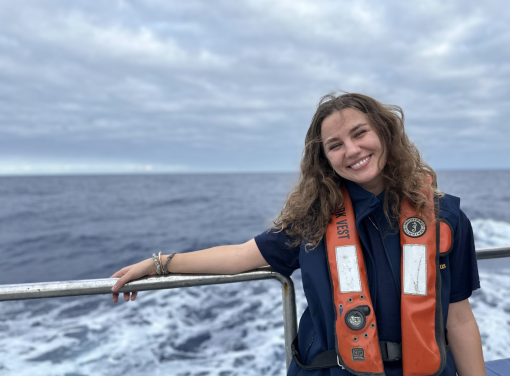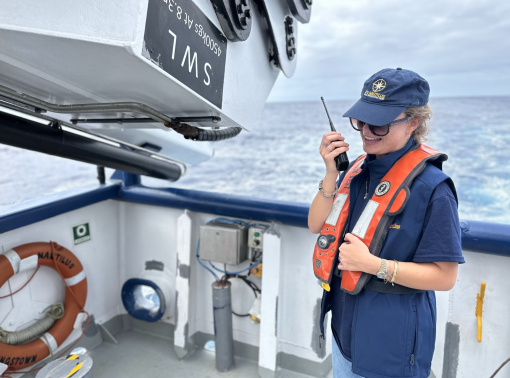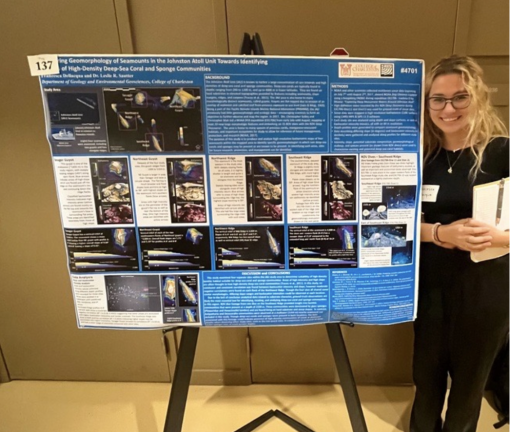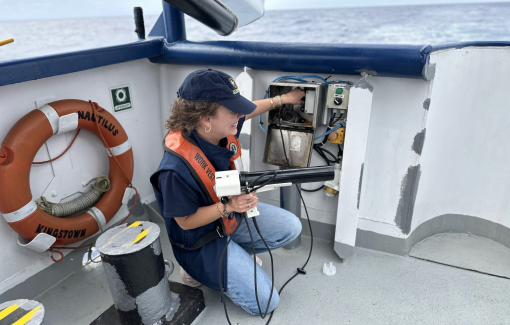Francesca Dellacqua Weaves Marine Biology and Software Engineering to Map the Seafloor

To accomplish the many expedition objectives of seafloor mapping, the Ocean Exploration Trust employs three programs – Fledermaus, Qimera, and Qinsy – produced by the maritime software company Quality Positioning Services. Seafloor mappers aboard E/V Nautilus use each of the programs for different purposes, simultaneously streaming multiple monitors in the ship’s Data Lab to ensure full and accurate coverage of the ocean floor.
For the first time, Francesca Dellacqua joined Nautilus as a member of the seafloor mapping team as part of the NA162 expedition, a 10-day and 2,400 nautical mile mapping transit from British Columbia, Canada to Honolulu, Hawai’i. As a QPS support technician when onshore, Dellacqua’s work involves providing support for vessels conducting seafloor mapping. While at sea, her role requires a variety of day-to-day tasks, from deploying sensors from the aft deck of the ship to tracking quality data and adjusting the multibeam sonar mapping system.

Before moving into the field of software engineering, Dellacqua was first drawn to the ocean through the study of marine biology. She began her career while studying at the College of Charleston in South Carolina where she dissected and analyzed regional juvenile sharks to examine microplastic ingestion. It was during this time that she was introduced to the university’s Benthic and Acoustic Mapping and Survey, program, also known as BEAMS.
“My study included using multibeam and backscatter data alongside remote operated vehicle (ROV) imagery, and other mathematical analysis tools to determine areas on seamounts and ridges where deep-sea coral and sponge communities are present or thriving,” said Dellacqua.
“This was a great combination of many things that I’m passionate about, and truthfully it opened up my mind to the world of hydrography. Taking advantage of my education helped me immensely in discovering what I would eventually do for work.”

After graduating, Dellacqua realized her desire to work directly with software programs like those used during her research program. QPS offered the experience, progression, and forward-facing perspective she sought to launch her career, which she says allows her to learn something new every day, travel to wonderful places, and meet all different types of people.
With this role, however, comes challenges. As a woman in the software development field, she notes that it is sometimes difficult to be taken as seriously as her male peers.
“I find that sometimes as a woman, and as the type of person I am, I’m not taken as seriously as others, specifically older men in the field,” Say says. “As long as I achieve my personal goals and continue to push to learn more, do better, and make myself proud, I know that I’m on the right track.”
She credits her success to two very important female mentors: Deborah Febres Urdaneta, her current manager at QPS, and Dr. Leslie Sautter, her college advisor.

“Having such intelligent and strong female mentors has made me almost oblivious to the tribulations of being a woman in the field, as they show by example that women can truly do anything they want, no matter what stereotypes exist within the hydrographic (or engineering, or software programming) field,” said Dellacqua.
For women in the field interested in pursuing a similar track, Dellacqua recommends attending the “highly inspirational” Empowering Women in Hydrography conference.
And for those hoping to follow in her footsteps, Dellacqua says to put yourself out there:
“I would recommend others to get experience getting out on a vessel! My time so far on Nautilus has taught me soo much more than I even thought, and I can see how important it is to get the experience of participating in different types of surveys while living offshore.
“My other suggestion to others is to study as much as you can in whatever fields you find interesting. Luckily, in this field, there is a great amount of opportunity and high demand for intelligent and hard-working individuals, so choose what interests you and explore what companies or routes you can take with it!
“There are many many options available and I have learned that the only limitations are those that you put upon yourself. In the future I hope to learn more about programming and software development, to go beyond the practical usage of the software and understand the builds behind it. Also, there is still so much to be mapped! It is very exciting in a way to be a part of such a relevant field, especially in surveys and expeditions related to conservation and environmental purposes.”

OET has many hydrography and other education-related resources for those interested in becoming better acquainted with the field, some of which are linked below:
- Bathymetry: Making Topographic Maps
- Building Underwater Features Using Sonar Mapping
- Seafloor Mapping Simulation
- Mapping Vocab Explainer: Hydrography & Cartography
- Five Fun Facts About Multibeam Mapping
- Mapping to the Speed of Sound: How UCTD Instruments Inform Acoustic Mapping

Mapping the Gaps Southbound
This expedition is a seafloor mapping mission to bring E/V Nautilus from British Columbia back to the Central Pacific for subsequent expeditions of the 2024 field season. This 10-day transit route will fill gaps in seabed mapping within and beyond the U.S. EEZ and thereby support priorities of Seabed 2030, the Ocean Networks Canada Strategic Plan, and the US National Strategy for Mapping, Exploration, and Characterization.



